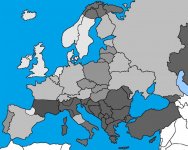martiko
martiko
- Messages
- 213
- Reaction score
- 10
- Points
- 0
- Ethnic group
- european : basqueR1b/IberianI2b
- Y-DNA haplogroup
- R1b-DF100
- mtDNA haplogroup
- T1a1
https://www.google.fr/search?q=Gulf...mD8ex0AX2uoDYAw&ved=0CEEQsAQ&biw=1250&bih=874
any theory suffers from these exceptions.
If Norwegian is very distinctly in dominant feature R1b, it is less fact for Swedish who conceal I1 and a little fewer R1a a lot.
Dautre leaves, the cattle need rich regions with fatty pasture and it corresponds in Europe western and going of the centre of Spain to to the south of the Sweden (effect Gulf Stream).
I think that the addition of several reasons can over a period of 4000 years to have influenced populations is placed side by side and they find a similar result for I2a1 in Spain and different from I2a1 in Sardinia.
They will note representativeness of put together MtDNA H1 er H3 which seems to be dominant features among DF27 and L21, is very represented in suede, north Spain and in Finland with its peaks to Basque / iralndais.
Therefore really genetic neighbourhood, geographical / climatic environment; more the time play an important role.
They also see the presence of T2 who is not tolerant in lactose in the east south of the Europe and the Turkey, Ukraine, and who seems to accompany Y DNA J2 and E1 ; in the opposite the presentation of T* / T1, who is very tolerant in lactose, among the Kurds, bashkirs, Balts, Arab (Druse / Palestinian) and who seems to accompany R1a and J1 and also in the steppes and the Ural R1b / Q1a.
And it seems still in that case to separate the populations of stockbreeders with the populations of farmers.
any theory suffers from these exceptions.
If Norwegian is very distinctly in dominant feature R1b, it is less fact for Swedish who conceal I1 and a little fewer R1a a lot.
Dautre leaves, the cattle need rich regions with fatty pasture and it corresponds in Europe western and going of the centre of Spain to to the south of the Sweden (effect Gulf Stream).
I think that the addition of several reasons can over a period of 4000 years to have influenced populations is placed side by side and they find a similar result for I2a1 in Spain and different from I2a1 in Sardinia.
They will note representativeness of put together MtDNA H1 er H3 which seems to be dominant features among DF27 and L21, is very represented in suede, north Spain and in Finland with its peaks to Basque / iralndais.
Therefore really genetic neighbourhood, geographical / climatic environment; more the time play an important role.
They also see the presence of T2 who is not tolerant in lactose in the east south of the Europe and the Turkey, Ukraine, and who seems to accompany Y DNA J2 and E1 ; in the opposite the presentation of T* / T1, who is very tolerant in lactose, among the Kurds, bashkirs, Balts, Arab (Druse / Palestinian) and who seems to accompany R1a and J1 and also in the steppes and the Ural R1b / Q1a.
And it seems still in that case to separate the populations of stockbreeders with the populations of farmers.
Last edited:




